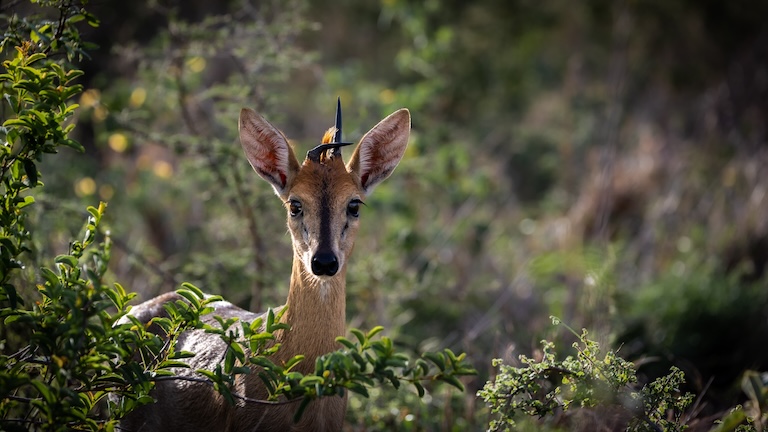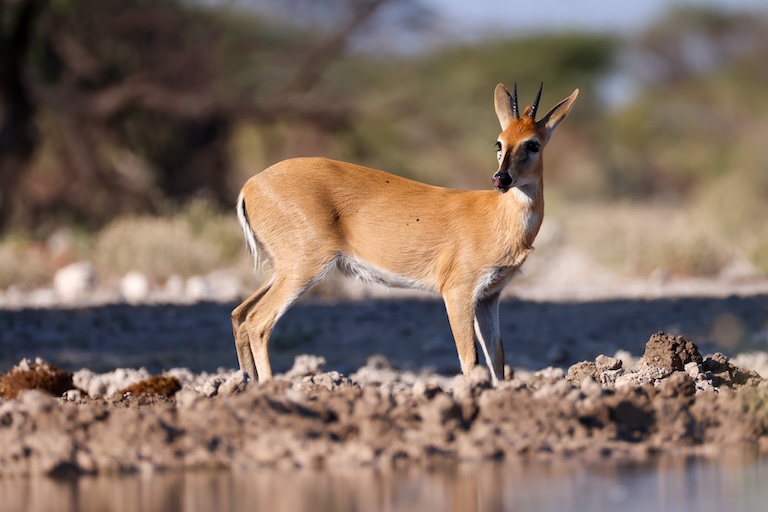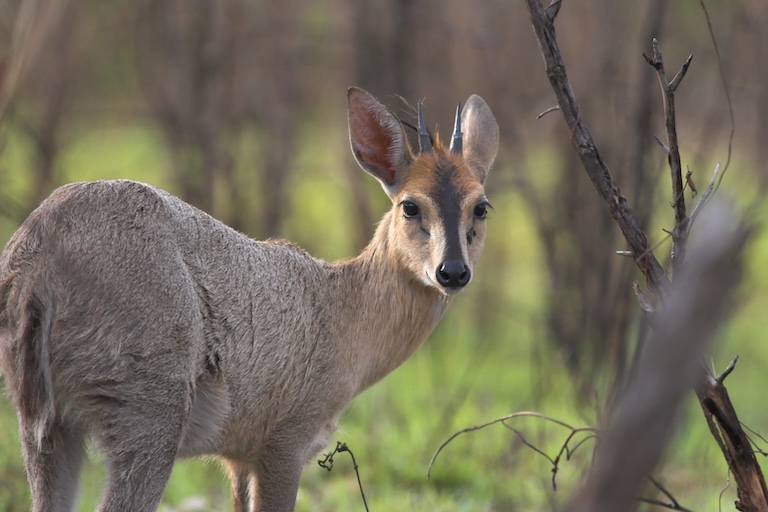Duiker Profile
Medium-sized animals are always overlooked. Foxes and jackals are mid-tier predators and don’t get the attention of the wolves or snakes on either side of their scale.
Tuna aren’t as interesting as sharks for the same reason, and duikers, medium-sized antelope from Sub-Saharan Africa, are living in the shadows of elephants and rhinos, despite being more abundant and just as ecologically important.
We’re here to push back against this oversight and represent the unsung heroes of herbivory.

Duiker Facts Overview
| Habitat: | Heavily wooded areas with clearings |
| Location: | Sub-Saharan Africa |
| Lifespan: | Around 11 years in some species |
| Size: | Smallest are around 36 cm (14 inches) tall, largest 87 cm (34 inches) |
| Weight: | Smallest around 5 kg (11 pounds), largest 80 kg (180 pounds) |
| Colour: | Usually golden to dark brown, sometimes black |
| Diet: | Generalist browsers, insects and carrion |
| Predators: | All large carnivores |
| Top Speed: | Unknown, but fast! |
| No. of Species: | 22 |
| Conservation Status: | Least Concern to Endangered (IUCN) |
Duikers are a group of roughly 22 species of small-to-medium, African browsing antelope. They’re dotted about the continent quite widely, and often share a habitat with one another, leading to some interesting strategies to avoid competition.
This complexity supports a richer web of ecology, and as such, the disruption to duiker communities that human presence brings can result in devastating effects for the entire network.
While these antelope are considered pretty mild as far as African animals go, it’s important that their role is recognized if we’re to understand the conservation needs of their habitats.
Interesting Duiker Facts
1. Holy duiker
The word duiker comes from the word for ‘diver’, which is a reference to how effectively these small bovids can get outta Dodge when threatened. They’re very fast when they need to be, and will dart around in all directions, diving into a bush as soon as they get the chance.
Their existence, while deeply under-appreciated by foreigners has been revered by traditions all over Africa.
The Garden of Eden trope has been around long before it was accommodated by the Biblical followers, and can be found in the ancient legends of various cultures. One such example comes from people in West Africa called the Bassari.
Their story of Unumbotte the creator, is the tale of the origins of humanity. Unumbotte created a man, then the animals including a duiker and a snake, and later a woman. This is quite a few steps more disrespectful to woman-kind, even than the biblical version, but there are similarities.

The snake persuades the humans to eat from a tree because they complain of being hungry, so Unumbotte gives them each food: the humans are given crops, the duiker is given grass and the snake is given venom and the urge to kill all humans.
So, the duiker has a firm place in local folklore, and this extends into more contemporary spiritual interpretations. The duiker is said to represent a connection to the natural world, as well as adaptability, survival instincts and agility. 1
2. They’re diverse
Duikers range in size from the blue duiker, one of the smallest antelope with 400g babies, to the larger species like the yellow-backed duiker that can reach upwards of 80kg.
They’re all generally recognisable as duikers from the shape of their heads and the common black stripe down the middle of their faces. They typically have small or no horns, shorty legs and dumpy bodies, but across the numerous species, there’s a wide range of sizes.
Females are a bit larger than males, and both usually have horns. One of the most recognisable features is the prominent scent glands beneath the eyes. These are used to mark their territories and one another’s rumps, which they do by rubbing their faces on one another.
What’s perhaps most counter-intuitive is the ability for many species of duiker to exist in the same spatial ecology.
3. They are an excellent example of niche partitioning
Competition is very expensive between animals. It takes a lot of resources to fight over or defend your food, and it’s much better for everyone if each species just finds its own unique way to share the space without conflict.
When similar species share the same space and feed on the same things, they have to come up with ways to avoid getting in each other’s way. Niche partitioning is the outcome of these various strategies, and it can involve the smallest of differences in behaviour.
Duikers avoid competition in a few ways. While they mostly eat the same things, many species will take shifts, sleeping when the others are awake, and vice versa.
If there are size differences, these generalist browsers will lean more heavily on the resources that they can handle better than their neighbours; larger species will tolerate more roughage than smaller ones and can focus more on hard foods like seeds and roots instead of taking the soft fruits that smaller species will need. 2

4. They can hunt
Like most herbivores, duikers are prone to their guilty pleasures. Animal protein is an easily digestible, rapid injection of high-density nutrients for most animals, and while duikers, like all bovids, are adapted for a herby diet, they would partake in a burger or two if the opportunity presented itself.
Duikers can’t work a grill, but they have been known to kill and eat small mammals like rodents, and they’ll happily feed on carrion where it’s available.
This overlap emphasises the adaptability of an already versatile group of animals and further contributes to their resilience in busy, multi-tiered communities of animals.
5. They’re so important
This complex coexistence makes the duiker’s conservation so significant to the ecosystem. Any disruption to the fine balance that these species have evolved can create a cascade of negative effects that increase competition, and screw up the entire diplomatic process.
And this is why even a rudimentary understanding of the fundamentals of ecology is so important to conservation. We tend to focus a lot on species that are globally endangered, but the local effects of disruption can be severe, and have widespread consequences for biodiversity and the health of the ecosystem.
And duikers are a great example of this.
6. Habitat loss and exploitation are threatening this balance
One of the most common ways of hunting in the African woodlands is by snare. Snares are such a tremendous threat to wildlife populations because of how indiscriminate they are. Snares are also easy to hide and a much lower profile method of poaching in protected areas.
Like ecological land mines, they can sit forgotten for years, able to maim and kill long after the hunter has moved on.
It’s not uncommon to see chimpanzees with limbs missing from being caught in snares, as can many other species if they survive at all.
Duikers are one of the targeted species of snares all over Africa, and snare trapping is one of the most serious threats to the most endangered species, like the Abbot’s duiker.
Habitat loss is occurring all over the world, and duikers are of course subject to this disruption too. Agricultural expansion threatens to collapse the intricate community structure of many species before they’re even understood by ecologists, and several species are barely studied. 3
Duiker Fact-File Summary
Scientific Classification
| Kingdom: | Animalia |
| Phylum: | Chordata |
| Class: | Mammalia |
| Order: | Artiodactyla |
| Family: | Bovidae |
| Tribe: | Cephalophinae |
Fact Sources & References
- “DUIKER”, San Diego Zoo Safari Park.
- Herbert H T Prins (2006), “Co‐existence and niche segregation of three small bovid species in southern Mozambique”, Research Gate.
- “Abbott’s Duiker”, IUCN Red List.
